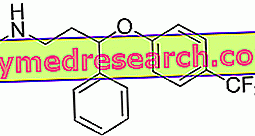Fluoxetine is an antidepressant drug belonging to the class of selective serotonin (or SSRI) reuptake inhibitors. It is perhaps best known under the trade name Prozac®.

Fluoxetine - Chemical Structure
It was discovered by the pharmaceutical company Eli Lilly Company and in 1987 its use was approved by the US Food and Drug Administration.
It is considered a very important drug, so much so that it is included in the list of essential drugs prepared by the World Health Organization (WHO). In this list, all the drugs that must be present within a basic health system are listed.
Indications
For what it uses
The use of fluoxetine is indicated in the treatment of:
- Episodes of major depression;
- Obsessive-compulsive disorder;
- Bulimia nervosa;
- Moderate to severe major depressive disorder in children and adolescents. In this case, however, fluoxetine must be prescribed in association with psychotherapy.
Warnings
Depression is associated with an increased risk of suicidal thoughts, self-harm and suicide. Since the improvement of these symptoms may not occur immediately in the first periods of treatment, it is advised to supervise the patients until such improvement is achieved.
Administration of fluoxetine in children and adolescents under the age of 18 can lead to suicidal behavior. For this reason, children and adolescents who are being treated with the drug must be constantly monitored in order to identify early suicidal symptoms.
Growth and pubertal development should be monitored in children and adolescents treated with fluoxetine, as this may cause delayed puberty.
Fluoxetine may have convulsive effects, therefore caution should be used when administering the drug in patients with a history of convulsions.
The administration of fluoxetine should be avoided in patients suffering from unstable seizure disorders or epilepsy. Patients on the drug with controlled epilepsy should be closely monitored.
The use of fluoxetine should be discontinued if the patient enters a manic phase.
The drug should be administered with caution in patients with a history of manic disorders.
Treatment with fluoxetine may cause an alteration of glycemic control in patients with diabetes. Dose adjustments of insulin and / or oral hypoglycemic agents used to treat this disease may be necessary.
Interactions
The combination of fluoxetine and selective monoamine oxidase inhibitors (MAOIs) of type A should be avoided.
Concomitant administration of fluoxetine and type B MAO, on the other hand, requires clinical monitoring of patients, due to an increased risk of the onset of serotonin syndrome.
Concomitant administration of fluoxetine and phenytoin (a drug used to treat epilepsy) may cause changes in the plasma concentration of fluoxetine itself. Such alterations can cause very dangerous toxic effects.
Fluoxetine can cause alteration of the plasma concentration of tamoxifen (an anticancer drug), for this reason a lot of caution must be used in a concomitant administration of these two drugs.
The combination of fluoxetine with the following drugs increases the risk of the onset of serotonin syndrome:
- Tramadol (an opioid painkiller);
- Hypericum (or St. John's Wort, a plant with antidepressant properties);
- Tryptophan (the amino acid from which serotonin is synthesized);
- Lithium (used for the treatment of bipolar disorders);
- Triptans (medicines used for the treatment of migraine).
Furthermore, the association with triptans increases the risk of developing coronary vasoconstriction and hypertension.
A lot of attention must be paid to the concomitant administration of fluoxetine and drugs that can affect the heart rhythm, such as, for example:
- Antiarrhythmic drugs, such as flecainide and encainide ;
- Antipsychotics, such as phenothiazine, pimozide, clozapine and haloperidol ;
- Tricyclic antidepressants (TCA), such as imipramine, desipramine and amitriptyline ;
- Antimicrobial agents, such as sparfloxacin , moxifloxacin, erythromycin and pentamidine ;
- Antimalarial drugs, such as halofantrine ;
- Antihistamines, such as astemizole and mizolastine .
The metabolism of fluoxetine affects mainly the liver enzyme system of cytochrome P2D6, therefore, the concomitant use of drugs also metabolized by this enzyme system can lead to drug interactions.
Since fluoxetine can cause abnormal bleeding, great care must be taken with the concomitant administration of oral anticoagulants (such as, for example, warfarin ).
Electroconvulsive therapy in combination with fluoxetine therapy can cause prolonged convulsions, or increase their frequency in patients with pre-existing seizure disorders.
The combination of alcohol with drugs that inhibit serotonin reuptake (including fluoxetine) should be avoided.
Side effects
Fluoxetine can cause a series of side effects that can vary - by type and intensity - from one patient to another, due to the different sensitivity that each person has towards the drug.
The following are the main adverse effects that may occur during fluoxetine therapy.
Allergic reactions
Treatment with fluoxetine can trigger allergic reactions in sensitive individuals. The symptoms that can occur are rash, itching, hives, anaphylactoid reaction, vasculitis (inflammation of blood vessels) and angioedema.
Gastrointestinal disorders
Fluoxetine therapy may cause nausea, vomiting, diarrhea, dyspepsia and dysphagia . Fluoxetine can also cause dry mouth and alterations in the sense of taste .
Nervous system disorders
Administration of fluoxetine may cause:
- Headache;
- dizziness;
- Changes in sleep (such as insomnia or the appearance of abnormal dreams);
- Euphoria;
- Abnormal and uncontrollable movements (such as, for example, nervous tics);
- Convulsions;
- Psychomotor restlessness;
- Hallucinations;
- Confusional state;
- agitation;
- Anxiety;
- Panic attacks;
- Concentration disorders;
- Cognitive process disorders;
- Suicidal behaviors and / or thoughts.
Sexual dysfunctions
Treatment with fluoxetine may cause delayed or absent ejaculation and priapism (a syndrome characterized by painful erection in the absence of sexual arousal).
Disorders of the kidneys
Fluoxetine therapy may cause an alteration in the frequency of urination and urinary retention .
Serotonin syndrome
Fluoxetine can cause serotonin syndrome, especially when it is given in combination with other drugs that can enhance the serotonin signal.
It is a syndrome characterized by an excess of serotonergic activity in the central nervous system; it is also referred to as a serotonin poisoning .
Intoxication can be mild, moderate or severe and the symptoms that characterize it usually appear very quickly.
As for the mild form, the symptoms that can manifest are:
- Tachycardia;
- Chills;
- Increased sweating;
- Headache;
- Mydriasis (dilation of the pupils);
- Tremors;
- Myoclonia (short and involuntary contraction of a muscle or a group of muscles);
- spasms;
- Accurate reflexes.
In the case of moderate intoxication, however, they can occur:
- Accentuation of intestinal sounds (borborigmas);
- Diarrhea;
- Hypertension;
- Temperature.
In the case of severe intoxication, there is a marked increase in heart rate and blood pressure. The patient may also enter a state of shock with body temperatures exceeding 40 ° C.
Rhabdomyolysis (rupture of skeletal muscle cells and their release into the bloodstream), convulsions and renal failure may also occur.
hyponatremia
Treatment with fluoxetine may cause hyponatremia, ie it may cause a decrease in plasma sodium concentration. Generally, this is a reversible side effect that regresses when therapy is stopped.
Respiratory disorders
Fluoxetine can cause dyspnea and pharyngitis . More rarely, the drug can promote the development of inflammatory and / or fibrous processes .
Suspension symptoms
Abrupt discontinuation of fluoxetine treatment can cause so-called withdrawal symptoms, such symptoms are:
- dizziness;
- paresthesia;
- Insomnia and sleep disorders in general;
- Asthenia;
- Anxiety;
- agitation;
- Nausea and / or vomiting;
- Tremor;
- Headache.
Generally, these symptoms occur in mild form, but in some patients they may also occur in a severe form.
Maniacal reactions
Cases of manic reactions including mania and hypomania have been reported following treatment with fluoxetine in pediatric patients.
Other side effects
Other adverse effects that may occur following fluoxetine therapy are:
- Hemorrhagic manifestations;
- Galactorrhea, ie the abnormal secretion of milk in women who are not breastfeeding;
- Tremors;
- Light sensitivity;
- Anorexia;
- Idiosyncratic hepatitis (in very rare cases);
- Abnormal liver function tests;
- Alopecia;
- Changes in vision;
- Stuttering;
- Muscle pains;
- Epistaxis;
- Whistling in the ears;
- Decrease in the number of platelets;
- Inflammation of the throat;
- Growth retardation and delayed sexual maturation in pediatric patients.
Overdose
Symptoms caused by an overdose of fluoxetine include:
- Nausea and vomit;
- Convulsions;
- Cardiovascular dysfunction;
- Cardiac arrest;
- Pulmonary dysfunction;
- Altered condition of the central nervous system that varies from excitation to coma.
In very rare cases, fatal outcomes have occurred following overdosage.
There is no antidote for overdose, however, induction of vomiting or gastric lavage may be useful. A remedy, even more useful, could be the administration of activated charcoal used in combination with sorbitol.
Action mechanism
Various hypotheses have been formulated on the possible causes of depression, one of which is the monoaminergic hypothesis.
According to this hypothesis, depression would be caused by a deficiency of monoamines, such as serotonin (5-HT), noradrenaline (NA) and dopamine (DA). Therefore, antidepressant therapies should be aimed at correcting these deficiencies.
Serotonin is believed to be the main neurotransmitter involved in depressive disorders and alterations in its transmission are associated with all mood disorders.
Serotonin is synthesized in the presynaptic nerve endings starting from the amino acid tryptophan, stored in vesicles and released in the synaptic wall (the space between the presynaptic and postsynaptic nerve endings) following certain stimuli.
Once released from the nerve termination, 5-HT interacts with its receptors, both pre- and postsynaptic. After having explained its action, serotonin binds to the transporter that operates its reuptake (the SERT) and is brought back into the nerve end.
Fluoxetine is a drug that is part of the serotonin reuptake inhibitors.
In particular, fluoxetine has a high affinity and selectivity towards SERT and - by binding to it instead of serotonin - it causes the neurotransmitter to remain within the synaptic wall for a prolonged time, this induces an increase in the serotonergic signal on receptors postsynaptic with consequent improvement of depressive pathology within a few weeks.
Mode of Use - Posology
Fluoxetine is available for oral administration in the form of hard capsules, soluble tablets or oral drops.
The tablets can be taken whole or dissolved in half a glass of water.
The capsules, on the other hand, must be taken without chewing.
Fluoxetine can be given in single or fractionated doses, both near and far from meals.
The dosage of fluoxetine must be established by the doctor based on the type of pathology to be treated.
The patient must be carefully followed in order to check the progress of the therapy. If the doctor considers it possible - after a few weeks from the start of the treatment - a reduction of the administered drug can be evaluated.
The following are the usual doses of medication that are used in the treatment of different types of diseases.
Major depressive episodes (adults and elderly)
The recommended fluoxetine dose is 20 mg of drug per day. In case of an inadequate response, the dose can be increased up to a maximum of 60 mg of drug per day.
Obsessive-compulsive disorder (adults and the elderly)
Again, the recommended dose is 20 mg of fluoxetine per day. The amount of drug can be increased to 60 mg if patients do not respond adequately to the lowest dose.
Bulimia nervosa (adults and the elderly)
In this case the recommended fluoxetine dose is 60 mg a day.
Major to moderate episodes of major depression in children aged 8 years and older
The administration must take place under the strict control of a specialist. The usual dose of fluoxetine is 10 mg, but the amount of the drug can be increased up to 20 mg.
In children whose weight is below the norm a lowering of the dose of fluoxetine administered may be necessary.
Dosage reduction may be required in patients with pre-existing liver dysfunction.
The drug dose should also be reduced in patients where there is a possibility of interaction between fluoxetine and other drugs taken in combination.
Pregnancy and breastfeeding
Fluoxetine - if it is deemed necessary by your doctor - could be given during pregnancy. In any case, a lot of caution must be used, especially during the last stages of gestation or just before the start of labor, as in newborns adverse effects have been reported such as:
- Irritability;
- Persistent crying;
- Tremor;
- hypotonia;
- Difficulty sucking or sleeping.
Because fluoxetine is excreted in breast milk, mothers treated with the drug should not breast-feed.
Contraindications
The use of fluoxetine is contraindicated in the following cases:
- Known hypersensitivity to fluoxetine;
- During the administration of non-selective monoamine oxidase inhibitors;
- In conjunction with the administration of type A monoamine oxidase inhibitors;
- During breastfeeding.



